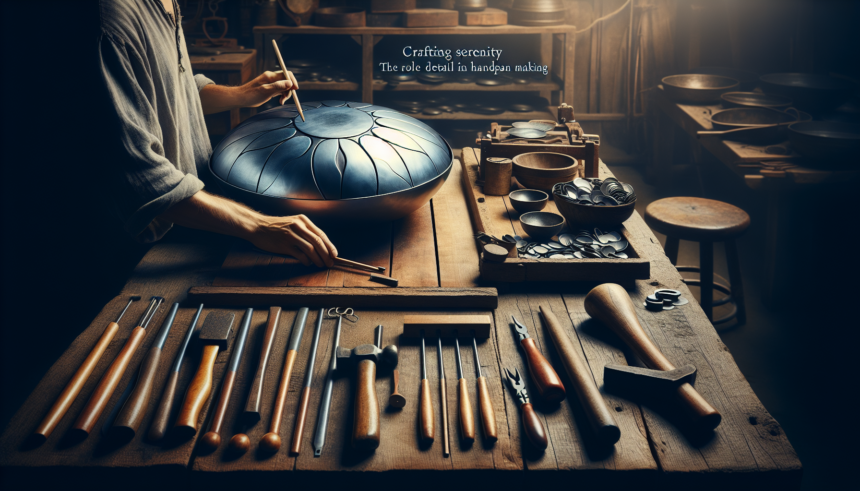In a world where industrial processes dominate, handpan making stands as a beacon of meticulous craftsmanship and soulful artistry. These enchanting instruments, characterized by their ethereal tones and resonant harmonics, are the embodiment of dedication and attention to detail. Each handpan is not just a musical instrument; it’s a carefully forged piece of art that holds within it a story of precision, passion, and patience.
The Birth of a Handpan: A Journey of Precision
The art of handpan making begins with an understanding of the materials involved. Most handpans are crafted from a type of steel, which can vary from nitrided to galvanized or raw steel. The selection of the material significantly influences the final sound and the durability of the instrument. The journey from a flat sheet of metal to a harmonious instrument is intricate, requiring skillful hands and a meticulous approach.
The initial step is the creation of the steel shell. This involves deep drawing, a process where the metal is stretched and formed into a domed shape. Precision is key here; any imperfections during this early stage can affect the instrument’s tuning and overall sound quality. The resulting shells are then carefully examined, and those that meet the stringent standards move forward in the process.
Sculpting Sound: The Tuning Process
Tuning a handpan is an art form in itself. Each note area, or tone field, is painstakingly hammered into the steel shell. This requires an acute understanding of acoustics and a highly trained ear. The craftsperson strikes the steel at specific points, adjusting the tension and curvature to create precise frequencies.
The tuning process is iterative, involving countless adjustments and retuning to achieve the perfect pitch. This meticulous process ensures that each tone field resonates harmoniously with the others, giving the handpan its signature soundscape. Crafting the ding, the central note on the top of the instrument, is particularly challenging. It must be perfectly aligned to set the tonality for the entire handpan.
Heat Treatment: Strength and Resilience
After the initial tuning, the handpan undergoes a process known as heat treatment. This step serves to harden the steel, enhancing the instrument’s resilience and stability. Heat treatment also plays a crucial role in maintaining the tuning over time.
The handpan is heated to specific temperatures, often in a controlled environment, and then cooled gradually. This process requires exceptional control and precision, as any variations can introduce unwanted stress into the material, potentially affecting the sound quality. Post heat treatment, the instrument is checked again for any changes in tuning, and minor adjustments are made as necessary.
Adding the Finishing Touches: Assembly and Decoration
With the shell prepared and tuned, the next step is the meticulous assembly of the two halves, creating the complete instrument. A careful sealing process ensures that the handpan maintains its structural integrity and sound quality. This is followed by decorating the surface, where artisans may add intricate designs that reflect both personal and cultural inspirations.
The decoration is not merely aesthetic; it often holds symbolic meanings and provides a visual representation of the harmony contained within. Many handpan makers use natural patinas or finely detailed engravings to add a bespoke feel to each instrument. This final touch personalizes the handpan, connecting the maker’s story with the player’s journey.
Conclusion: The Harmony of Craft and Art
The creation of a handpan is far more than the birth of a musical instrument; it is a harmonious blend of physics, craftsmanship, and artistic vision. Every handpan is a testament to the maker’s dedication to detail and devotion to their craft. The precision required at every stage ensures that each instrument transcends mere functionality to become a source of serenity and inspiration for its players.
In a world increasingly driven by automation, the handpan stands as a symbol of the profound impact of human touch and careful attention to detail. It reminds us of the beauty that arises from patience and the extraordinary sounds that the hands of skilled artisans can bring into existence. Serenity, found in each resonating note, is the ultimate gift of the handpan, crafted with unwavering dedication and an unyielding commitment to perfection.
Frequently Asked Questions (FAQs)
1. How long does it take to make a handpan?
The time required to craft a handpan varies significantly depending on the complexity and the maker’s expertise. Generally, it can take anywhere from 40 to 100 hours over several weeks to complete one handpan, considering the various stages from shaping to tuning and finishing.
2. Why are handpans so expensive?
Handpans are costly due to the intricate and labor-intensive process involved in their creation. Each instrument is hand-crafted, tuned, and refined with exceptional care, requiring skilled artisans who invest a substantial amount of time and expertise. Additionally, the materials used, such as specialized steel, contribute to the overall costs.
3. Can a handpan go out of tune?
Yes, handpans can go out of tune over time, particularly if they are exposed to significant temperature changes, physical impacts, or improper handling. However, with proper care and occasional retuning by skilled professionals, a handpan can maintain its beautiful sound for many years.
4. What is the difference between a handpan and a steel drum?
While both instruments are made from steel, handpans and steel drums have distinct differences. Handpans typically have a more ethereal, melodic sound with fewer overtones and a central ding note. In contrast, steel drums, originating from Trinidad and Tobago, have a brighter, more percussive sound and are often used in larger ensembles.
5. How do I care for my handpan?
Caring for a handpan involves regular cleaning with a soft cloth and oiling it to prevent rust. It’s important to store the instrument in a stable, climate-controlled environment and avoid exposing it to harsh elements. Transporting it in a protective case can also help preserve its integrity and sound quality.





